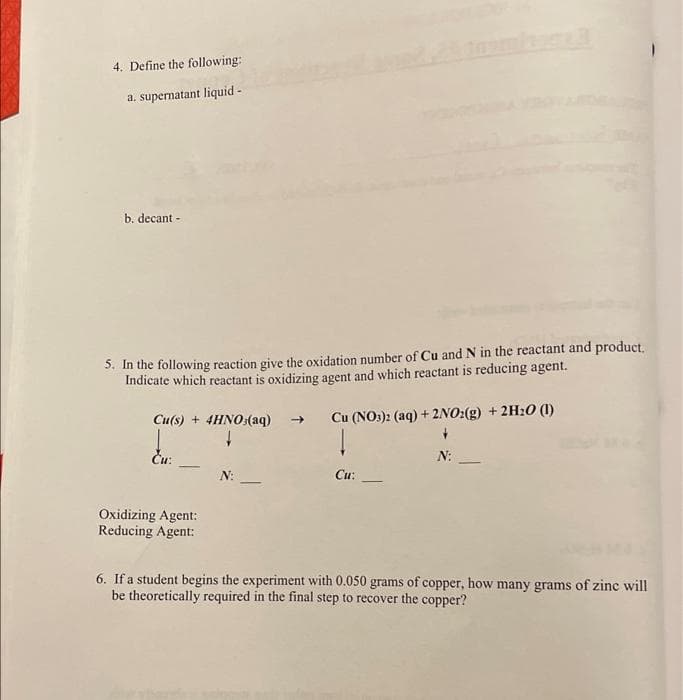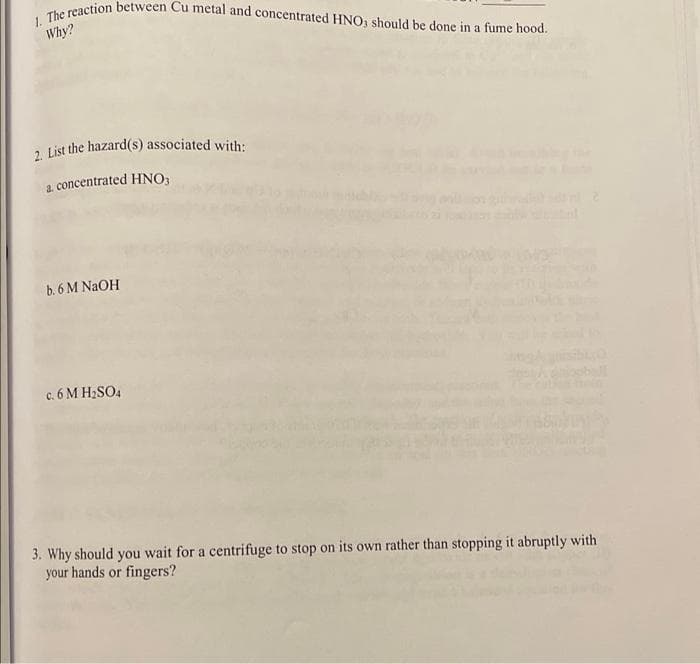Chapter21: Synthesis Of N-butyl Bromide And T-pentyl Chloride
Section: Chapter Questions
Problem 2Q
Related questions
Question
Solve all parts otherwise I will downvote

Transcribed Image Text:4. Define the following:
a. supernatant liquid -
b. decant -
5. In the following reaction give the oxidation number of Cu and N in the reactant and product.
Indicate which reactant is oxidizing agent and which reactant is reducing agent.
Cu(s) + 4HNO:(aq)
Cu (NO:): (aq) + 2NO:(g) + 2H20 (1)
->
Ču:
N:
-
N:
Cu:
Oxidizing Agent:
Reducing Agent:
6. If a student begins the experiment with 0.050 grams of copper, how many grams of zine will
be theoretically required in the final step to recover the copper?

Transcribed Image Text:1. The reaction between Cu metal and concentrated HNO3 should be done in a fume hood.
Why?
a list the hazard(s) associated with:
a. concentrated HNO3
b. 6 M NAOH
c. 6 M H2SO4
3. Why should you wait for a centrifuge to stop on its own rather than stopping it abruptly with
your hands or fingers?
Expert Solution
This question has been solved!
Explore an expertly crafted, step-by-step solution for a thorough understanding of key concepts.
Step by step
Solved in 3 steps

Knowledge Booster
Learn more about
Need a deep-dive on the concept behind this application? Look no further. Learn more about this topic, chemistry and related others by exploring similar questions and additional content below.Recommended textbooks for you

EBK A SMALL SCALE APPROACH TO ORGANIC L
Chemistry
ISBN:
9781305446021
Author:
Lampman
Publisher:
CENGAGE LEARNING - CONSIGNMENT

Chemistry for Engineering Students
Chemistry
ISBN:
9781285199023
Author:
Lawrence S. Brown, Tom Holme
Publisher:
Cengage Learning

Chemistry by OpenStax (2015-05-04)
Chemistry
ISBN:
9781938168390
Author:
Klaus Theopold, Richard H Langley, Paul Flowers, William R. Robinson, Mark Blaser
Publisher:
OpenStax

EBK A SMALL SCALE APPROACH TO ORGANIC L
Chemistry
ISBN:
9781305446021
Author:
Lampman
Publisher:
CENGAGE LEARNING - CONSIGNMENT

Chemistry for Engineering Students
Chemistry
ISBN:
9781285199023
Author:
Lawrence S. Brown, Tom Holme
Publisher:
Cengage Learning

Chemistry by OpenStax (2015-05-04)
Chemistry
ISBN:
9781938168390
Author:
Klaus Theopold, Richard H Langley, Paul Flowers, William R. Robinson, Mark Blaser
Publisher:
OpenStax

Chemistry & Chemical Reactivity
Chemistry
ISBN:
9781337399074
Author:
John C. Kotz, Paul M. Treichel, John Townsend, David Treichel
Publisher:
Cengage Learning

Chemistry & Chemical Reactivity
Chemistry
ISBN:
9781133949640
Author:
John C. Kotz, Paul M. Treichel, John Townsend, David Treichel
Publisher:
Cengage Learning